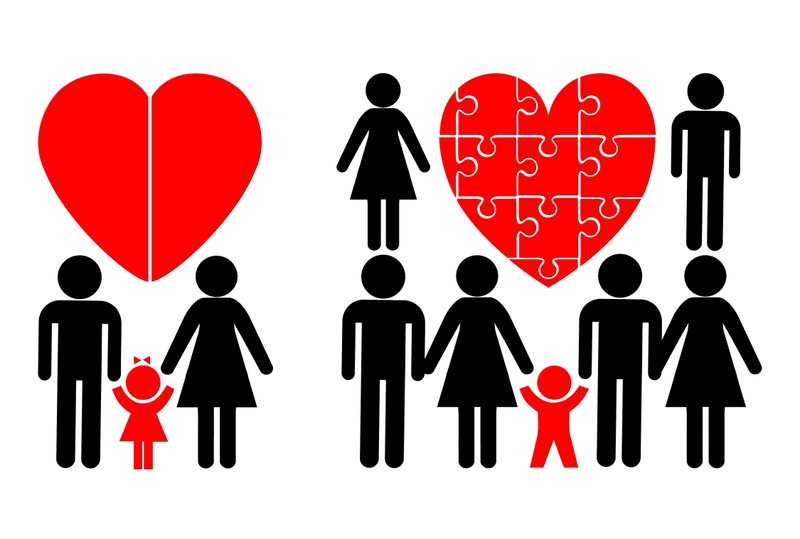I never set out to be the poster mom for blended families. DC and I were both married before, for happily ever after. His wife died. My marriage hit the rocks. And three years ago we gave marriage another shot. Today we are a blended family of five arguably grown children (his three plus my two), who range in age from 23 to 38 and live scattered like dandelion thistle across four states.
Actually, we're double blended. When DC married his first wife, she had a 5-year-old son, so DC's eldest is a stepson. We are a mixed, colorful, widespread, crazy quilt American family. And we are the norm.
In America, the intact, biologically bonded, mother-father-and-child family is not the rule. The recoupled family is, says Dr. Jeannette Lofas, president and founder of The Stepfamily Foundation, and author of five books on stepfamilies.
"Today, 60 percent of families live in some form of divorced or stepfamily relationship," she says, a family in which one or both partners has children from a prior marriage. In America, 1,300 new stepfamilies form every day.
As the female lead of this new ensemble, I looked around for the blended-family playbook, and didn't find one. While I will leave the subject of how to negotiate the psychological repercussions of these transitions to those who have a lot more letters after their names than I do, here's what I can tell you: Home design has a role.
How you decorate your house shows kids -- regardless, of whether they live with you full time, part time or just visit, whether they're in diapers or in high school, off to college or off making their own homes -- their place in the new normal.
"Whether they say so or not, the question kids need answered when their families transform is where do I fit in?" says design psychologist Toby Israel, of Princeton, N.J.
My job, and yours, if you, too, are at the helm of one of these households, is to show these kids through home design that they do fit in, that they belong, and that they know, because you've shown them and told them, there will always be a home for you here.
Here are eight ways to help blended kids feel at home:
• Provide equal representation. If you have all your son's soccer trophies and memorabilia on display, but precious little reflecting your partner's daughter's debate championships, balance the scales. The kids will notice. Even if one child acts as if he or she doesn't care, don't believe it.
• Display photos with intention. The family photo wall or table is symbolic, and is an opportunity to show the blended family coming together. The kids will be looking, believe me, at how they fit in, and who's most prominent. Set out photos that make kids feel at home -- but at your home, not a haunted place from either partner's past. Even if one child is camera shy and another loves the limelight, photos on display should show all offspring equally.
• Get literal. Names painted above coat hooks, monogrammed on pillowcases or engraved on matching mugs give kids a sense of belonging, that all are of one tribe.
• Create a space for them. Until kids grow completely out of the home and are well on their way, every child should have a place in the house that is just his or hers. This doesn't have to be an entire room, but a shelf, a chest, a desk, or a drawer, Israel says. Don't violate the space by putting other things there when they're not around. "The amount of stuff or the size of the space one controls doesn't matter so much as the feeling that you have control over your things," says Dr. Michelle Janning, professor of sociology at Whitman College, in Walla Walla, Wash. "If you start to get invaded, that is an important sign of a problem."
• Include them in the housework. To make kids feel like part of the household, don't treat them as guests, Lofas says. "Everyone has a job. You make the salad. You empty the dishwasher. You set the table. Everyone cooks." Being part of a family means taking part in the running of the household, and not sitting on the sidelines.
• Create rituals. Traditions are part of what defines a family. Creating new or continuing old family traditions with new family members goes a long way toward knitting blended families together. To build a network among our far-flung family, we send a group text on every member's birthday. That way everyone can easily send a warm wish, a secondary reminder of the extended blended family we all belong to.
• Show respect. You can't make blended family members love one another, but you can teach them to respect one another. Dr. Marilyn Coleman, professor of human development and family science at the University of Missouri, says she often hears men complain about the lack of respect their new wives have for their belongings and their child's things. One man complained that his wife put all of his beloved Western-style furniture in his daughter's room and would allow none of it in the rest of the house. "The underlying message was disrespect for his things, and for his daughter who had no say in the matter," she says.
• Celebrate the lessons. "Family is where we learn," Lofas says, "and that is especially true in blended families, which teach us 30 ways of looking at life, as well as important lessons about assimilating and adapting, and that everyone brings you something. They offer much to celebrate."
Syndicated columnist Marni Jameson is the author of five home and lifestyle books, including Downsizing the Family Home -- What to Save, What to Let Go and the forthcoming Downsizing the Blended Home -- When Two Households Become One (Sterling Publishing, Dec. 2019).
HomeStyle on 04/20/2019
